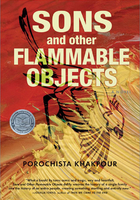TIPS
AND
TRICKS
Professional cooks use a battery of tricks to make their work easier. You can do the same at home with these tips.
SERVE EXCITING FOOD & DRINK
My cooking is influenced by the cuisines of Spanish-speaking countries around the world. Even though I was born in Mexico and cooking with chilies is literally second nature to me, I also enjoy playing with the flavors of Peru's Japanese Nikkei culture, so I cook with Asian ingredients, too. I love sharing new culinary discoveries with my friends. Intriguing cooking does not happen without interesting ingredients, so if you are not familiar with some of these groceries, please expand your culinary horizons… and then sit back and wait for the compliments.
DO YOUR HOMEWORK
Read the recipe a couple of times to be sure that you understand the instructions and their sequence. Every good cook knows the concept of layering flavors and textures to build a cohesive culinary masterpiece. At a glance, you may think that a recipe looks complicated or beyond your skill set. Read it again, and you are likely to find that the recipe really isn't that hard, but just made up of various components, many of which are made ahead and assembled right before serving. After all, that is how many restaurants work. I don't make salsa a couple of minutes before I serve it, or the food would never get out onto the tables.
PLAN AHEAD
Especially when you are making a dish for the first time, use mise en place, the classic chef's technique of preparing every necessary component before you begin cooking. This way you won't be digging through a cupboard looking for a key ingredient at a crucial point in the recipe.
MAKE AHEAD
Look for the components that can be made ahead. I've provided make-ahead instructions whenever possible. Please… use them!
SUBSTITUTE AS NEEDED
As a restaurateur with operations on both coasts and in between, I travel all over the country. I have been pleased to see how formerly unusual (and delicious) ingredients can now be purchased at supermarkets, as new immigrants bring their cooking to America. That being said-don't be afraid of making a substitution. I have provided substitution suggestions for unusual ingredients, but everything in this book is readily available at Latin and Asian markets and most supermarkets. To order online, check the Resources on this page.
DON'T SPREAD YOURSELF TOO THIN
Balance your menu with easy and slightly challenging recipes. A complicated menu is a recipe for disaster. A great selection of cheese is always a welcome appetizer, and a simple variety of fresh, ripe fruit is a satisfying dessert, especially when the choices include papaya, mango, and other fragrant and juicy tropical treats. Simplifying these two courses means that you can spend a bit more energy on the remaining dishes. Conversely, spend the time making a showstopping appetizer or dessert, and then do an easy grilled main course. That's how I entertain at my house.
THE
LATIN
PANTRY
Here is a listing of basic ingredients that can be stored at room temperature in a cool, dry place.
AGAVE
A sweetener derived from the agave plant (typically the same blue agave variety also used to make tequila), this Mexican syrup has a texture and flavor reminiscent of honey. The harvested sap is heated and filtered to obtain three different nectars of varying sweetness levels: light (mild), amber (moderate), and dark (strong, similar to maple syrup). There is also raw (actually minimally heated) agave nectar. Amber agave nectar is the most versatile of the three major varieties, and it can be found at natural food stores and most supermarkets. I use agave in cooking and as an alternative sweetener for simple syrup in cocktails.
CHILIES, DRIED
The dehydrated fruits of the capsicum plant, dried chilies are an essential ingredient in Mexican cuisine. Drying preserves the chile and concentrates its flavor. When a fresh chile is dried, its name changes. For example, when a fresh red jalape?o is smoked and dried, it becomes a chipotle, and a dried poblano is renamed an ancho.
Whole dried chilies are easily available at Latin markets and are showing up more and more at general supermarkets. Of course, they are easily purchased online, but it is most economical to buy them in bulk to save on postage. Stored in zip-top plastic bags in a cool, dry place, dried chilies maintain their flavor for about six months, or they can be frozen for up to a year.
There are many alternatives to whole dried chilies, such as pure ground ancho or chipotle chilies, cayenne pepper, and hot sauces. Virtually every supermarket now carries jars of ancho and chipotle powder in the spice aisle. (Chili powder is a spice blend of mild ground chile, cumin, oregano, and other seasonings for flavoring a pot of chili. It is not the same as pure ground chilies, which will have the chile variety clearly marked on the label.) These products can be used without soaking. Their minor drawback is that they don't add body to the sauces like the whole chilies. Flavor differences are a small issue because an ancho does not taste exactly like a guajillo, but to the untrained palate, the difference will not be noticeable.
PREPARING DRIED CHILIES
Whole dried chilies are sometimes toasted and soaked before using. The toasting brings out flavor nuances and soaking rehydrates the chilies for smooth puréeing.
Cut off and discard the stem from each chile, if necessary. Tear or cut the chile open lengthwise, shake out the seeds, and cut away the ribs. Most of the heat is stored in the chile seeds and ribs, so if they are not removed, the finished dish will be too hot.
Heat a medium heavy skillet, preferably cast iron, over medium-high heat. Add the split chilies and press them against the skillet surface with kitchen tongs. Cook, turning them occasionally, until the chilies are more pliable and give a toasty fragrance (but don't breathe in the fumes too deeply, as they can be irritating), 1 to 2 minutes. The chilies should be toasted in spots, but not burned.
There are literally thousands of different chilies, but here is the core group used in this book:
Ancho: The dried version of the fresh poblano chile, the ancho is wide, wrinkled, and blackened red in color. Only moderately hot, with an underlying raisin-like sweetness, ancho is also available in supermarkets as a pure ground chile. Ancho, guajillo, and pasilla chilies are pretty similar in flavor, so it is no crime to substitute ground ancho for the other chilies in this trio when necessary.
Chile de árbol: Small chilies about the size of a pinky finger, these little guys are very hot, and are used when a noticeable heat is required.
Chipotle: Smoked red jalape?os, chipotles are fiery hot with lots of smoky flavor. They are commonly sold in canned, dried, and ground versions.
Canned chipotles packed in adobo have mainstreamed into a supermarket item. Leftover chilies, with the adobo (a vinegary red chile sauce), should be transferred to a covered container and refrigerated, where they will keep for a couple of months, as both the vinegar and chile act as natural preservatives and discourage molding. For longer storage, space individual chilies (with the adobo) on a parchment- or waxed paper–lined plate, and freeze until solid. Remove from the paper, transfer them to a zip-top plastic bag, and freeze for up to a few months. They only take a few minutes to thaw.
Dried chipotles are dark beige, and should be stemmed, seeded, and rehydrated before using. Morita (see entry) is a variation of dried chipotle.
Pure ground chipotle power is very useful as a substitute for other varieties of whole dried chilies.
Guajillo: Elongated, with a deep red, shiny skin, the guajillo is one of my favorite chilies. It has a fruity, berry-like flavor behind its warm (but not too hot) spiciness, which gives it a flavor profile similar to the ancho.
Morita: The morita chile has the dark purple color of a small mulberry (morita in Spanish). Related to the common dried chipotle, the morita is smoked for a shorter period of time, giving it a different color, softer texture, and fruitier flavor.
Pasilla: Also known as chile negro, this is the dried version of the chilaca chile, which is not used much in its fresh incarnation. Black and wrinkled, it is a bit narrower and more elongated than an ancho.
Soaking chilies: Place the toasted chilies in a small bowl just large enough to hold them. (If you wish, tear the chilies into pieces to help them fit into the bowl.) Add enough boiling water to cover them and let them stand until softened, 20 to 30 minutes. Drain the chilies, reserving the soaking water if the recipe requires. The chilies are now ready to be pureed or used as needed.
CHILE PASTES, PERUVIAN
American cooks are just discovering the delicious heat of the Peruvian chile (ají), of which over three hundred known varieties exist. These have not mainstreamed like Mexican chilies, and you cannot find the fresh versions in produce markets-yet. However, Peruvian chile pastes are sold in Latin markets and online. But if you are really interested in new flavors, search out the pastes, which are reasonably priced and, once opened, last for a few months in the refrigerator. You can always make a substitute with an equal amount of roasted and puréed bell peppers highly seasoned with hot sauce. The major types are:
Ají amarillo: A very hot, long yellow pepper, it is probably the most popular chile with Peruvian cooks and is used with everything from seafood to chicken. A substitute would be roasted yellow bell pepper purée seasoned to a fairly hot level with yellow or red hot pepper sauce.
Ají mirasol: This is the dried version of ají amarillo; a substitute would be roasted red bell pepper purée highly seasoned with red hot pepper sauce.
Ají panca: Because of its mild heat, this variety could be considered the poblano chile of Peruvian cuisine. If necessary, substitute roasted red bell pepper purée seasoned to a mild heat with ground ancho chile.
Ají rocoto: The fresh version of this fiery hot chile looks like a hot cherry pepper. It is the hottest of the commercially available pastes. You could substitute a roasted jalape?o (preferably red) purée or, if it is used in small quantities, Chinese chili sauce.
CHOCOLATE, MEXICAN
Mexican chocolate is different from American chocolate, as it is made to be melted with milk to become hot chocolate. Shaped into round disks that can be cut into individual wedges for single servings, it is gritty with sugar and flavored with a hint of cinnamon. Look for it in Latin markets in a hexagon-shaped yellow box. Two popular brands are Ibarra and Abuelita (which means "grandmother" in Spanish and has a little old lady on the label). If you need a substitute, use 3 ounces (85 g) semisweet (not bittersweet) chocolate with about 55% cacao content and a large pinch of ground cinnamon for every disk of Mexican chocolate. A standard American brand, such as Baker's or Hershey's, works perfectly. The cacao content is often listed on the label.
CURRY PASTE, THAI
This Southeast Asian style of curry seasoning comes in three different colors and corresponding flavors: yellow (with turmeric and other Indian spices and the Thai additions of shallot and lemongrass), green (based on fresh green chilies, Thai basil, and cilantro), and red (made from fresh red chilies). I use red curry paste in the Thai Chicken Empanadas on this page. Look for it, sold in jars or small cans, at Asian groceries and well-stocked supermarkets and natural food stores.
DULCE DE LECHE
Many Mexican cooks make their own dulce de leche at home from milk and sugar slowly cooked until the milk solids in the mixture turn brown. (The sugars do not actually caramelize, a process that only happens at high heat.) It takes hours, but the good news is that canned or jarred dulce de leche is an excellent product and is becoming increasingly available in the Latin aisle of supermarkets.
FLOURS
Beyond the expected wheat flour, I use a few specialty flours in this book.
Almond flour: Also called almond meal, this used to be a specialty product only sold through baking supply companies, but the increased visibility of gluten-free foods has made it more readily available. It is no more than finely ground almonds. You'll find a reasonably priced, light brown version made from unskinned almonds at Trader Joe's. The ivory-colored type made from blanched almonds is more expensive. In the recipes in this book, it doesn't matter which one you use.
Arepas flour: Arepas, the Venezuelan and Colombian griddle cakes, require a special precooked cornmeal that doesn't have an American substitute-cornmeal just won't work. Sometimes labeled masa para arepas, it comes in white, yellow, and sweet yellow (made from a sweeter type of corn and not with added sugar) varieties. P.A.N., Areparina, and Goya (sold as Masarepa) are common brands. Latin markets carry it.
White rice flour: Milled from common white rice (although the one labeled "sweet rice flour" will work), this flour has no gluten, so it makes a particularly delicate batter for fried foods.
FURIKAKE
This colorful, flaky Japanese condiment looks like it would make a great cupcake topping, but it is savory and meant to be sprinkled on cooked rice. The main flavoring is dried fish flakes (either bonito or salmon) with seeds, seaweed, and other ingredients added to make at least six different kinds. I use a nori-and-sesame-seed furikake as a garnish for the Tuna Ceviche Nikkei on this page, but you can experiment with other flavors.
GINGER, PICKLED
The pink, thin slices of sweet pickled ginger served with sushi can be purchased at Asian markets and in the specialty produce section of many supermarkets.
GUAVA PASTE (MEMBRILLO)
This thick and sticky paste made from guava pulp reduced with sugar products is often served in slices with cheese as a dessert or snack in Spanish-speaking countries.
HEARTS OF PALM
You might be able to find fresh hearts of palm in parts of Florida (where it is known as swamp cabbage), but most of us will have to settle for the canned kind. That's okay because they are still very good-firm stalks of pale yellow vegetable that just might remind you of firm asparagus. They should be drained and rinsed before using.
HERBS, DRIED, & SPICES
Latin cooks use a fairly tight range of herbs (the leaves of edible, aromatic plants, used either fresh or dried) and spices (the dried bark, fruits, seeds, roots, or nuts of similarly fragrant plants). It is interesting to note that there aren't many examples of plants that are both an herb and a spice, the exceptions being dill and cilantro. Chilies are spices, but I have provided separate listings for both dried and fresh chilies.
It wasn't too long ago when many cooks had to rely on dried herbs for seasoning food. We now use fresh herbs with abandon for their bright, fresh flavor. However, there are occasions when the concentrated flavor of a dried herb is appropriate. For example, dried oregano has more impact than fresh. On the other hand, dried cilantro and parsley taste so little like their fresh versions that there should be a law against selling them.
As dried herbs and spices age, their essential oils evaporate and lose flavor. Stored in a cool, dark place (never near a hot stove) in airtight containers, they should last about six months. Get in the habit of marking the date of purchase on your dried herbs and spices so you can keep track of when it is time to replace them. It is a temptation to buy herbs and spices in bulk to save money, but that is immaterial if you don't use them up soon enough and they have to be discarded because they have aged and lost their flavor. Especially in Latin markets, you will see herbs and spices sold in plastic bags. Once they are opened, be sure to transfer them to an airtight jar or bottle for further storage.
Here are the dried herbs and spices that I use the most often in this book:
Annatto seeds: These reddish, triangular seeds come from the fruit of the achiote tree, grown in subtropical regions around the world. While it has an earthy flavor, most Americans unknowingly eat annatto most often as a food coloring, for it is often the ingredient used to give an orange or yellow color to otherwise naturally white cheeses. In the Latin kitchen, annatto plays a much larger role as a flavoring. It is ground with other ingredients to make achiote, a versatile seasoning paste (see this page).
Cumin, whole: The musky taste of cumin is found in many Latin recipes. While it is available ground, it is always at its best when the seeds are freshly toasted and pulverized in a spice grinder.
Oregano, Mexican: There are many varieties of oregano, all of which are members of the mint family. Most cooks are familiar with Mediterranean varieties, such as Greek or Italian. Mexican oregano is entirely different and has a bolder flavor, larger leaves, and a sharper aroma. While Mexican oregano is very easy to find at Latin markets and online, the Mediterranean variety can be substituted. However, for very little money and effort, you can bring this authentic Latin flavor to your cooking, so I encourage you to try it.
Paprika, sweet and smoked: The very best paprika comes from Spain and Hungary, but because the subject at hand is Latin cooking, let's limit our discussion to the Spanish variety (pimentón). Paprika is a very important flavor in Latin cooking and is used in everything from sauces to chorizo. You'll find two kinds commonly available: sweet (dulce, and the most versatile of the pair) and hot (picante). Smoked paprika (also labeled pimentón de La Vera, for its place of origin, a region south of Madrid) has been dried over smoldering oak and is a powerfully flavorful ingredient.
TOASTING & GRINDING SPICES
When whole spices are heated, their fragrant oils come to the surface and deliver deeper flavors. To do this, warm a small empty skillet over medium heat and add the whole spices. Cook, stirring almost constantly, until the aroma is distinct and the spices have turned a bit darker, about 2 minutes. In some cases, you may even see a wisp of smoke. Immediately transfer the spices to a plate to cool; if kept in the hot skillet, they will burn.
In Latin cooking, sometimes the spices are simmered in a sauce to soften, and then the entire mixture is ground in a blender. However, there are also instances where the toasted spices need to be ground without liquid. An electric coffee grinder (see entry in Equipment) with a rotating blade does the best job, as its small bowl contains the spices well. Surprisingly, a blender doesn't work as well.
HOISIN SAUCE
Sweet and salty, thick and deeply flavored with fermented soybeans, garlic, chilies, and spices, a spoonful of Chinese hoisin sauce is really a dipping sauce for Peking duck and moo shu pork, among other dishes. But with such a big flavor profile, it can also be used as a seasoning. Buy an imported brand at an Asian market (Lee Kum Kee is a good choice), and store it in the refrigerator for up to a year after opening.
JAMAICA (HIBISCUS BLOSSOMS)
Magenta-colored dried hibiscus blossoms (jamaica) can be brewed into hot or iced tea and are used in ponche, the warm Mexican Christmas punch.
KABAYAKI SAUCE
Sometimes labeled unagi (eel) sauce because it is the soy-based glaze used on barbecued (kabayaki) eel sushi, this sauce is easily found at Japanese markets and supermarkets in Asian communities. There is a homemade version on this page.
MAGGI SEASONING
This salty seasoning is an umami bomb that will boost the flavors in your cooking. It is a close relative of the hydrolyzed vegetable protein that you see listed in many processed foods, and is basically sodium and monosodium glutamate (MSG) in a liquid form. The difference is that this MSG is naturally produced from processed soy (or wheat) and not artificially created. You may be shocked at its components, but used in small quantities, as I do, it is many a chef's secret ingredient. It is an especially popular seasoning with Mexican cooks. Soy sauce is an acceptable substitute.
MAYONNAISE
I use two kinds of mayonnaise in this book. For most recipes, a high-quality American brand, such as Hellman's or Best Foods, is perfect. When the recipe has an Asian inspiration, I recommend Kewpie, a Japanese product that has a creamier consistency and is less tart than American mayo, which can certainly be used instead.
MIRIN
Similar to sake, this sweetened rice wine gives luster to cooked Japanese sauces and is a flavor booster, too. (Alcohol is known to amplify the taste of the other ingredients in a dish, one reason why you find beer, wine, and other spirits as cooking liquids.) Mirin is now sold in the Asian section of most supermarkets. However, this industrial product (aji-mirin) is usually sweetened with corn syrup and does not have the depth of flavor of the traditional naturally fermented variety (hon-mirin). While hon-mirin is harder to find, most cooks find it is worth the effort to locate it at a Japanese market. Just look for brands without added sugar products or sweeteners, and you'll know that you are getting a superior mirin.
MOLE
This thick sauce of ground chilies, spices, nuts, seeds, and other ingredients dates back to Aztec times, and varies from region to region. You'll find green, black, orange, and yellow (and colors in between) at markets in Mexico. Stateside, you can buy basic brown mole (mole poblano) and green mole (mole verde) pastes at Latin markets. These are diluted with broth to make a mole sauce for meats or poultry. The oils from the nuts and seeds always rise to the top of the paste (like natural peanut butter), and must be stirred into the solids before using. This is easiest to do by scraping the contents of the jar into a small bowl and mashing it together with a fork. I sometimes use just a tablespoon or two of mole paste as a seasoning in a sauce. Any leftover mole can be frozen in an airtight container for up to three months.
PILONCILLO
Unrefined sugarcane juice dried and molded into a rectangle or cone, piloncillo is sometimes called panela to avoid confusion with queso panela cheese, and you will often see it labeled as such in Latin markets. The hard sugar with a strong molasses flavor must be crushed before using-chip away chunks from the rectangle with a meat pounder, and pound the chunks in a heavy-duty plastic storage bag until crushed. Raw sugar, such as demerara, is a good substitute, and dark brown sugar will suffice.
PONZU
This is a yuzu-flavored soy sauce used for dipping sushi, which I use as a seasoning. There are many good bottled brands, but it is also easy to make your own. Use the recipe on this page.
RICE
While long-grain rice rules the roost in the American kitchen, short- and medium-grain rices are popular in other cuisines. In general, the shorter the grain, the starchier the rice. For example, Japanese cooks use sticky short-grain (sometimes labeled as medium-grain) rice to mold into sushi. (But this is not the sticky or sweet rice of Southeast Asian cuisine, which is even more adhesive.) Medium-grain arborio rice is essential for risotto because its starch releases into the cooking liquid to provide the proper creamy consistency. Long-grain rice cooks into individual grains that should not (when cooked properly) stick together. Latin cooks often prefer medium-grain rice because the clinging grains are easier to spoon out of a casserole. For example, paella is always made with medium-grain rice, such as Spanish Calaspara and Bomba.
SOY SAUCE
The ubiquitous Japanese brand of soy sauce, Kikkoman, may be an industrial product, but it is conscientiously made with highly consistent quality. There are countless Chinese brands, but they vary greatly. To know what you are getting every time (since it is easy to over- or under-season with an unfamiliar soy sauce) Kikkoman is a good choice. I also encourage using low-sodium soy sauce.
SWEET CHILI SAUCE, THAI
Another dipping sauce, great with spring rolls, egg rolls, and the Venezuelan teque?os on this page. You can find it at supermarkets, although it is more reasonably priced at Asian markets.
TAMARIND
Valued for its tart flavor, tamarind is used in Latin, Southeast Asian, and Indian cuisines. While fresh tamarind is often sold at ethnic markets, the sticky flesh must be extracted from the tough brown pods, moistened with liquid, and strained through a sieve to remove the many seeds. It is more common to see tamarind pulp packed in blocks in the produce department of Latin markets. The pulp is added to liquids and then strained to remove any seeds. At Asian and Indian markets, look for tamarind concentrate, which is ready to use and requires no preparation.
TOGARASHI, SHICHIMI
While Mexican cooks are known for their way with chilies, shichimi togarashi (which translates to seven-flavor chile pepper) makes a claim for the Japanese talent with hot condiments. Sold in small (about .63-ounce or 18-gram) jars for easy transport, it is a beautifully fragrant spicy seasoning blend of coarsely ground red pepper with six of the following ingredients: ground sansho (also called Japanese peppercorn), dried or toasted orange or yuzu peel, black or white sesame seeds, hemp (but not cannabis!), ground ginger, dried shiso leaf, and black or white poppy seeds. It is a basic item at Japanese markets. Togarashi purchased online in bulk, instead of in the typical small jars, can be reasonably priced.
TORTILLAS
Flat cakes made from either wheat flour or lime-treated ground corn, tortillas are synonymous with Mexican cooking. Even though you can make them by hand, it is a labor of love. Whenever possible, choose refrigerated tortillas over the shelf-stable ones-they simply taste better and have better texture. There's a huge difference between brands, so experiment until you find one that you like (the tortillas should be flavorful and chewy and not dissolve easily on contact with sauce).
Corn tortillas come in just one size, about 6 inches (15 cm) in diameter. Flour tortillas are available from small to large diameters, but I use the small 6-inch (15-cm) size almost exclusively for soft tacos and serving with queso fundido.
VINEGAR
All vinegar is acetic acid made from the ethanol created by the fermentation of a base ingredient. The acid is then diluted with water, which is what the percentage number means on commercial vinegar labels. Vinegar is created either by a natural slow fermentation or by a fast fermentation where the base is inoculated with bacteria to make it sour quickly. Each vinegar has its own flavor, and they can easily bring variety to your cooking.
Cider vinegar is quite tart, and the apple cider provides a background fruity note to the acidic flavor.
Distilled white vinegar is not actually distilled but made from distilled alcohol, and is useful for its neutral color and taste.
Rice vinegar, a standard ingredient in Asian cuisine, is one of the mildest vinegars. Be sure to buy the unseasoned variety, and not the seasoned one with sugar and salt that is used to moisten rice for shaping into sushi.
Sherry vinegar is fermented from Spanish sherry, and has dark brown color and rounded, slightly sweet flavor.
White balsamic vinegar has the complex flavor of commercial balsamic vinegar, but not the dark coloring.
WASABI, POWDERED
Fresh wasabi is a rhizome related to horseradish. Peeled and grated, its green flesh is a condiment for sushi. Because the fresh version is perishable, dehydrated and ground wasabi is sold as a powder that can be reconstituted with water into a paste. I use it as a hot and spicy seasoning in some of my Nikkei dishes.
YUZU JUICE, BOTTLED
Yuzu is popular in Japanese cooking, with a bumpy orange-to-green peel and a unique tartness that is a cross between lime and grapefruit. Its juice is used to flavor everything from ponzu (the soy sauce dip) to vinegar. Fresh yuzu is a delicacy, and is only found in season at Japanese markets, although it is gaining ground with American chefs, so who knows when you might buy it as easily as pomegranates? Until that happens, use bottled yuzu juice, found in the vinegar section of Japanese markets, or fresh lime juice.
REFRIGERATED
AND
FROZEN
This is a listing of basic ingredients that should be stored in the refrigerator or freezer.
CHEESES, MEXICAN
Mexican cheeses play an important role in Latin cuisine-imagine your favorite enchiladas without a topping of creamy melted cheese. Imported Mexican cheeses are not widely distributed, even in Latin communities, but American-made cheeses in the same style are just as good. Yet even those you may not find easily. Don't worry, as the recommended substitutions work perfectly and you shouldn't think that you are taking a step down.
Chihuahua: A great melting cheese; substitute mild Cheddar.
Cotija: This firm, salty, off-white cheese is often crumbled over cooked food just before serving. Ricotta salata is a good substitute.
Cotija, grated: Aged cotija is sold refrigerated and pre-grated to sprinkle over food before cooking, similar to Italian grating cheeses like Romano, which is a fine substitute.
Queso fresco: Another semi-firm cheese that crumbles easily; substitute ricotta salata or a mild feta.
Oaxaca: Very similar to string cheese or mozzarella, this cheese melts smoothly.
Queso panela: This fresh cheese, shaped and drained in a small basket (panela), is often sautéed quickly in a hot nonstick skillet to give it a browned surface. You may find a similar cheese called queso de freir (frying cheese). Farmer's cheese and mozzarella can be prepared in the same way.
CHORIZO
Spicy with chilies and paprika and seasoned with vinegar, there are two distinct versions of this Latin sausage. Spanish-style smoked chorizo is sold in short or long links, and with a pepperoni-like texture, it is hard enough to slice or dice. Mexican-style soft chorizo has the texture of breakfast sausage and is sold in bulk or in plump links.
CREMA, MEXICAN
This is cream that has been naturally fermented to give it tang. Some cooks refer to crema as Mexican sour cream, but it is actually thinner and milder than the American product. Look for brands that have a Mexican name or labels with the Mexican flag's colors of red, green, and white because many Latin countries have a version of crema, and each is unique. To make a substitute for Mexican crema, thin ? cup (120 ml) crème fra?che or sour cream with about 3 tablespoons whole milk to give the mixture a texture that is thin enough for drizzling.
FRUIT PURéES, FROZEN
Latin markets carry a large selection of frozen fruit purées. These are much more economical than making them from scratch, and their flavor is excellent, as they are processed from fruit at its seasonal peak. I use mango and passion fruit in the recipes in this book.
MISO
Miso is a salty, umami-rich paste created from soy, with the addition of white or brown rice or barley. The array of misos at an Asian market can be confusing to the uninitiated. I only use white miso (shiromiso) in this book. Shiromiso isn't truly white, just light in color compared to the other varieties, which, depending on the amount of aging and its specific ingredients, can range from slightly red (akamiso) to deep chocolate brown. If the label says "medium-sweet," don't let that throw you, because it refers to the miso's relative saltiness and not its sugar level.
PRODUCE
These are the various fresh fruits and vegetables that can give your food Latin style.
CHILIES, FRESH
It wasn't too long ago that the only chile an American cook could buy at the supermarket was the canned green variety. Now you'll find a rainbow of fresh chilies in the produce aisle. (Young chilies are green and change to red as they age on the plant, their flavor mellowing along with the chameleon-like color change.) Along with the familiar Mexican varieties like jalape?o and serrano, you'll often find such popular Asian chilies as twisty cayenne or small (and incendiary) Thai bird chilies.
If you have sensitive skin, be sure to wear latex or rubber gloves to keep the irritating chile oils off your skin. If you do get burned, dab the area with milk, heavy cream, or yogurt, as capsaicin (the hot element in the chile) is not water soluble, but will disperse in butterfat. A cold beer will make your mouth feel better by numbing the area, even if it doesn't neutralize the capsaicin.
To chop fresh chilies, slice off the stem and cut the chile in half lengthwise. Using the tip of a small, sharp knife, cut away the thin ribs and seeds inside the chile. The chile is now ready for chopping into smaller pieces. If the recipe calls for chile rounds, cut the stemmed chile crosswise, and then remove the seeds and ribs from each round with the tip of the knife.
The skin of fresh chilies can be tough and not that pleasant to eat. In many cases, the chilies are roasted (actually, charred) before chopping to blacken and blister the skin to make it easier to remove. There are three easy ways to roast whole chilies (the stem, seeds, and ribs are removed after charring):
Broiler: This is an especially good method to roast a quantity of chilies. Position a broiler rack about 6 inches (15 cm) from the source of heat and preheat the broiler on high. Spread the whole chilies on the broiler rack and broil, occasionally turning the chilies with kitchen tongs, until the skins are blackened and blistered (but not burned through the flesh), about 10 minutes, depending on the heat of the broiler and the distance from the heat source.
Gas burner: An alternative way to roast chilies requires a gas range. It works well when you want to roast only a chile or two. Turn the burner on high and place the chile directly on the metal grate. Letting the flames touch the skin, turn the chile with tongs as needed until the skin is completely charred.
Grill: If you have an outdoor gas grill, it is a snap to grill a large number of chilies. (Don't bother to build a charcoal fire for this, unless you have subsequent grilling to do.) Preheat the grill on high for about 10 minutes. Spread the chilies on the grill grate. Cook, with the lid closed as much as possible, turning the chilies occasionally with tongs, until the skin is blackened and blistered, 10 to 15 minutes.
When the chilies are blackened, transfer them to a heatproof bowl. Cover the bowl with plastic wrap to create steam in the bowl. This will allow the chilies to cook a bit more and soften any skin that wasn't completely blackened by the heat. Let the chilies stand for about 15 minutes. Uncover the bowl, being careful of any steam. Using a small sharp knife, peel away the skin. Cut off the stem, slice the chile open, and discard the ribs and seeds. Do not clean the chilies under a stream of running water, as this only rinses away the flavor.
Because there are about twenty different kinds of commercially available chilies (and many more that can be grown in your garden), I'll only outline the ones used in this book.
Fresno: Very similar in appearance and flavor to the jalape?o, this chile has wider shoulders and a more pointed tip. It is sold in both red and green stages of ripeness, the red being older and slightly sweeter. Some cooks prefer using Fresno over the jalape?o because it has a thinner skin that makes for easier eating when used raw in salsas and the like.
Habanero: One of the hottest chilies, these have a wrinkled sphere shape and are sold in a mix of bright yellow, orange, red, and green colors; they add a particular flavor to the cooking of the Yucatan. Don't confuse it with the Scotch bonnet chile, which is more wrinkled and often somewhat larger, or the ají dulce, which is smaller; both of these are essentials in Caribbean cuisine. In a pinch, substitute Scotch bonnet for habanero.
Jalape?o: This is an excellent all-purpose chile for cooking in sauces and using raw in salsa. You'll find jalape?os at every supermarket.
Poblano: Deep dark green, with a shape like a flattened, elongated green bell pepper, this chile has a thicker flesh than other varieties, which makes it good for stuffing.
Serrano: This chile looks like a thinner jalape?o, and tastes a bit hotter.
CHAYOTE
This firm, pale green squash has a plump pear shape with vertical creases running down the skin. It should be peeled and its thick white seed removed before cooking. The flavor of chayote is mild and it works well with other vegetables. It releases a sticky juice when cut, so wash your hands after preparing the chayote.
GUAVA
Also called guayaba, the guava is a tropical fruit with a lovely sweet aroma and slightly acidic flavor. There is a range of varieties available at Latin, Indian, and Asian markets. Some have rough, bitter skin that must be pared away, while others have a thin skin that can be eaten like an apple. There are guavas with pink flesh and guavas with white interiors. Some are pear-shaped and some are round. And some people like to eat the crunchy seeds, while others find them too numerous to enjoy. The most common variety is pineapple guava, with pink flesh and not too many seeds. Guava should be ripened at room temperature until it "gives" when gently squeezed.
HERBS, FRESH
The lively flavor of fresh herbs is essential to good cooking. Don't underestimate their importance. Everyone knows that a sprinkle of chopped green herbs can rescue the appearance of dishes that are predominantly brown. But their main role is the bright taste they bring to food.
Cilantro: This herb embodies Latin cuisine, and it is also an important flavor in Southeast Asian cooking. Only a couple of decades ago, fresh cilantro was often labeled as coriander or Chinese parsley. But over the years, "cilantro" has come to mean the fresh herb, and "coriander" refers to the dried seeds used as a spice, with "Chinese parsley" falling out of fashion altogether. Many produce markets sell cilantro with the roots still attached, which is a quick visual way to differentiate it from Italian parsley.
PREPARING FRESH HERBS
Getting herbs ready for cooking starts when they arrive home with you from the market. Cilantro should be stored in a glass of water on a refrigerator shelf, like a bouquet, with a plastic bag covering the bunch. This protects the leaves from the cold air of the refrigerator, and gives the herb a longer shelf life. Rosemary, thyme, and other less delicate herbs can be stored in a plastic bag in the humidifier drawer of the refrigerator for about a week.
Before chopping, fresh herbs must be completely clean and dry. To start, rinse them well in a large bowl or sink of cold water. This is especially important with cilantro, which can be sandy. Pick off the number of leaves you'll need from the stems and dry the leaves well in a salad spinner. Use a very sharp knife to cut the herbs, because if they are bruised and not cleanly cut, they'll turn black around the edges. To store chopped herbs for a few hours (and have them ready to sprinkle over a dish as a garnish), wrap them in a paper towel and refrigerate.
While I occasionally use other fresh herbs (such as mint and parsley), cilantro shows up a lot in my recipes. But let's face it: A lot of people don't like cilantro. There have been recent studies that link the aversion to a person's genes, so the dislike is pretty deep-seated and a cilantro hater isn't likely to become a cilantro lover. If you have a dinner guest with this dislike, it's no big deal. Just leave the cilantro out of the dish, and offer it on the side for the cilantro fans to sprinkle on their food to taste.
JíCAMA
A squat tuber with a sweet flavor and crisp texture, jícama is peeled and usually served raw in salads.
LEMONGRASS
Fragrant with a strong citrus scent, this aromatic stalk is used a lot in Southeast Asian cooking. Buy moist-looking stalks with green tops and pale yellow bulbs and pass over any dried-out lemongrass. To prepare lemongrass, use a large knife to cut off and discard the upper woody top where it meets the paler, more bulbous lower stalk. Remove the first outer layer of the lemongrass bulb to expose the less tough inner flesh. The bulb can be sliced or chopped as required.
KAFFIR LIME LEAF
This very fragrant leaf is steeped in sauces to add its citrus flavor and aroma, and removed before serving. It is sold, fresh or frozen, at Asian groceries. If you can't find it, add the finely grated zest of a lime to the dish.
TOMATILLO
Sour and green with a papery husk, the tomatillo is more closely related to the gooseberry than the tomato. Its unusual taste is usually tempered with cilantro and chilies. Before cooking, remove the husk and rinse the tomatillo to remove its sticky natural coating. You will be sure to find tomatillos at Latin markets, although more and more supermarkets are stocking them.
YUCA
A tuber with scaly brown skin, yuca (also called cassava or manioc) is not attractive, but it is very tasty-even though it has a sticky texture that not everyone likes. Mashing and deep-frying are two common ways to cook fresh yuca, and it is also processed into tapioca and flour. Raw yuca is toxic, so don't nibble at the scraps during preparation. In spite of the sturdy-looking peel, yuca bruises easily, and is treated with a protective coating of wax before shipping. The peel, which is removed before cooking, is too tough for the average vegetable peeler, and must be pared away with a sturdy knife. After cooking, you will come across a tough cord in the center of the tuber, which should also be discarded.
EQUIPMENT
For my home cooking, I have a short list of what I consider to be essential appliances and utensils. Latin cuisine has its roots in rustic cooking, so when it comes to equipment, I prefer to do a lot with a little.
BLENDER
When it comes to Mexican cooking, the only electric appliance you really need is a blender. This handy, hard-working machine is required for puréeing the various ingredients in the many different chile sauces. A food processor is good for some jobs, but I don't use it nearly as much as my blender, as wet mixtures tend to seep through the processor's central hole, making a mess. Any blender will do the job, from a modestly priced model to a top-of-the-line super-mixer-as long as it has a glass container. The oils in dried chilies can stain, and could discolor a clear plastic blender jar. Handheld "stick" blenders are only okay, and not nearly as fast and efficient as the old-fashioned jar models.
One very important tip: Never purée hot food and always let it cool to tepid before processing in a blender. During puréeing, the hot mixture releases a vortex of pressurized steam that could blow the blender top off and shoot hot purée all over the kitchen (and your skin and clothes) in the bargain.
Some cooks vent the top hole in the blender lid to let the steam escape (or replace the lid with a kitchen towel to allow the steam to travel through the fabric weave), but I don't recommend a quick fix. To speed cooling, transfer the hot mixture to a heatproof bowl set in a larger bowl of iced water, and stir the food often to dissipate the steam.
SPICE GRINDER
Spices contain essential oils that are released by grinding. These oils begin to evaporate and lose flavor as soon as they are exposed to air, so freshly ground spices always taste better. Traditional Mexican cooking uses a molcajete (a stone mortar with a wooden or stone pestle) for this job, but an electric spice grinder is much faster.
The best spice grinder is actually an electric coffee grinder. Buy an inexpensive grinder with a rotary blade and dedicate it to spices. Don't use the same machine that grinds your coffee beans, or you'll end up with annatto-flavored java. To clean the grinder, process some raw rice or granulated sugar to absorb the residual spices. Toss out the rice mixture and brush the grinder bowl clean with a clean pastry brush.
You can also grind spices the old-fashioned way, with a molcajete or mortar and pestle and lots of elbow grease, but the investment in a time-saving electric grinder makes more sense for busy modern cooks.
HALF-SHEET PAN
Every professional kitchen has stacks of sturdy aluminum half-sheet pans for baking and roasting jobs. They do not have stacks of flimsy, thin cookie sheets! Half-sheet pans measure about 17 by 13 inches (43 by 33 cm) and are made to last. (A full sheet pan is very large and designed to fit in a commercial oven; a half-sheet is half its size.) When I use the term "rimmed baking sheet" in this book, I really mean a half-sheet pan, even if a lesser pan might get the job done.
FRUIT JUICER
I use a lot of fresh fruit juices in my cooking, so you will want to have an efficient, quick ream-type juicer. I like an inexpensive electric juicer-you'll have a cup of fresh orange juice in no time. At the very least, use a handheld citrus reamer. (See this page for more on fruit juicers for making drinks.)
V-SLICER
Professional chefs love plastic V-slicers to quickly cut ingredients into julienne or uniform slices. These lightweight tools are much easier to operate than a bulky metal mandoline. However, it is not an essential piece of equipment, and you can always cut the food by hand. Always use the holder to secure the food on the carriage-the blade is sharp and it is very easy to cut yourself, even if you are experienced. You can now purchase heavy gloves with protective mesh to wear while using a slicer. Even though a pair can cost as much as the slicer itself, I recommend at least one for the hand that will hold the food.













![火[合牛]供养仪轨](https://i.pgsk.com/images/book/2020/06/13/144230000.jpg)

